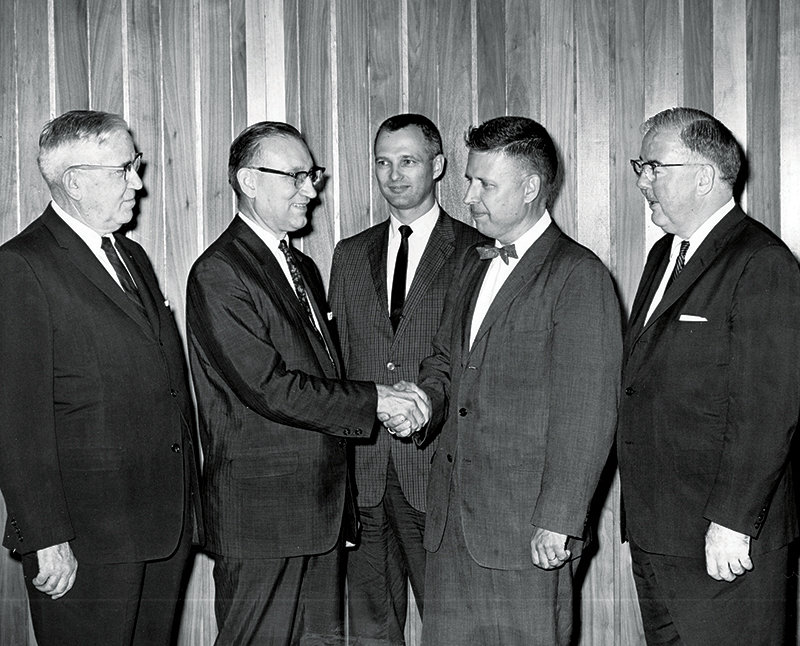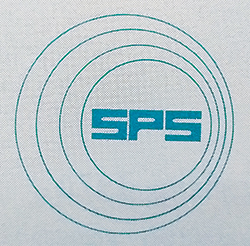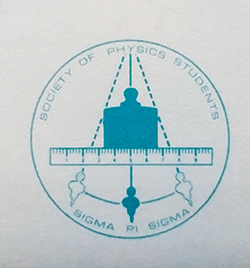Sigma Pi Sigma — A Departmental Legacy of Fellowship Part 4: SPS — A Society for All
Spring
2021
Unifying Fields
Sigma Pi Sigma — A Departmental Legacy of Fellowship Part 4: SPS — A Society for All
Brad R. Conrad, Director of the Society of Physics Students and Sigma Pi Sigma
Well before the 1968 creation of the Society of Physics Students from the merging of Sigma Pi Sigma (ΣΠΣ) chapters and American Institute of Physics (AIP) local student sections, physics departments from across the country knew that ΣΠΣ could do more. While ΣΠΣ was bringing together students from different class years (within individual departments) and helping to increase interactions with some alumni, not everyone could meet the high academic bar set by the honor society. As a member of the Association of College Honor Societies (ACHS), ΣΠΣ adhered to rules that standardized membership requirements for academic honors societies. Before the formation of SPS, correspondence between advisers and Marsh White, the administrative executive of ΣΠΣ, discussed ways to broaden the base of people who could benefit from the organization. For example, the Syracuse University chapter created an associate membership class for students who completed their first course in physics.1 This general observation—that all physics students within the department had need of something like ΣΠΣ—was also observed by the leadership of AIP.
Informal meetings during the early 1940s led Marsh White to formally approach Dr. Henry Barton, then AIP director, in 1948.2 White originally proposed that ΣΠΣ join AIP as a full membership society. Realizing the importance of helping students become professional physicists and astronomers, Dr. Barton created a special committee (consisting of AIP board members) to explore the idea and report back to the Board of Directors with recommendations. Through several meetings in 1948, AIP’s Policy Committee recommended that AIP should form a “special relationship” with ΣΠΣ, different from its relationships with the existing five Member Societies.3 In response, a joint ΣΠΣ/AIP committee comprised of active members from both societies was formed to investigate “other ways in which ΣΠΣ could satisfactorily be incorporated into AIP.”3 Discussions proceeded for several years, with progress shared regularly with ΣΠΣ membership through public and confidential correspondence. Much of the conversation focused on how to best serve departments and students “to develop spirit and also the beginnings of a professional society” among students. A primary concern for ΣΠΣ was how to preserve the pursuit of excellence on which ΣΠΣ was founded.
It’s important to note that ΣΠΣ’s regular correspondence with departments about these developments generated a large number of suggestions and public discussion. Publicly shared feedback tended to focus on the need for departmental and Member Society interactions, technical sessions (professional development) for students, and a need to increase alumni interactions across the sciences. Above all, the need to support “all students with an interest in physics” drove the conversation. In addition, the small society’s highly variable budget and financial instability hampered its ability to provide consistent student support in a shifting educational landscape. For example, early ΣΠΣ initiatives included graduate fellowships. A 1936 ΣΠΣ newsletter notes the fellowship value, $450 at the time, as less than ideal given that a $500 salary constituted comfortable living.4 ΣΠΣ also offered emergency student loans to students experiencing financial need (repayable, as they could afford), when it was financially able.

The joint ΣΠΣ/AIP committee, comprised of active ΣΠΣ and AIP Member Society members, ultimately recommended that AIP and ΣΠΣ work together to establish one home for physics students. To begin this complicated and long process, the committee recommended the formation of local student sections of AIP with a governance structure based on that of ΣΠΣ. This meant that a new organization could begin to take shape even as AIP and ΣΠΣ worked out the details of the formal agreement. A core tenet of the recommendation was that two separate societies for physics students would be a disservice to both the departments and the Member Societies. The formation of AIP chapters was not without considerable discussion, as at least four different versions of the local sections were developed before a consensus was reached. Participation in ΣΠΣ was to be actively encouraged in AIP chapters, and ΣΠΣ agreed to help support individual Member Society initiatives such as AAPT meetings, AIP careers services, and Physics Today. In the same spirit, ΣΠΣ petitioned APS leadership to create a membership category for graduate students.5
The collaboration continued to develop, as is evident by Marsh White’s 1947 Statistical Survey of PhD Physicists in Training.6 Data from the creation of ΣΠΣ chapters and local sections was then used by AIP to produce reports on enrollment and employment. Similar reports are still produced today through AIP’s Statistical Research Center. As a sign of good faith and a token of future collaboration, ΣΠΣ also financially supported AIP, as much as a small student society could, through a $500 donation to the building fund of AIP.7 As the magnitude of the endeavor to create what would become SPS was not wasted on the organizations, AIP, each of its five Member Societies, and ΣΠΣ ratified the creation of the AIP local student sections.
A model constitution for the local sections was developed by AIP in conjunction with ΣΠΣ through society leaders Homer Dodge, R. C. Gibbs, F. Wheeler Loomis, and Marsh White. That model is the basis of the constitution we use today.8 The term “local sections of AIP” was used as a temporary name to avoid any confusion around the two separate student organizations and to provide a “flexible plan” so that an agreement between ΣΠΣ and AIP could be found without rushing forward. As a first step toward a formal agreement, ΣΠΣ was accepted as an AIP Affiliate in 1951.
Conversations about how to best combine ΣΠΣ and the AIP local student sections continued through the 1950s and were driven by how to most effectively educate the growing number of future physicists, how to incorporate graduating students into Member Societies, and how to effectively govern a large chapter-based society while maintaining membership oversight. A large part of the delay between inception of the merger and full implementation came from eight years of negotiations with ACHS about how ΣΠΣ could remain a recognized honor society while sharing a constitution with a society that welcomes all. White’s desire to retire after 30 years accelerated the issue, resulting in the three-year process of voting to merge the societies. In August of 1966 the AIP Governing Board gave its unanimous approval to the merger plan. The same plan went for a final vote by 200 delegates representing 90 chapters at the 1967 Physics Congress and was approved by a one-vote margin!8 While the two societies were already intertwined, delegates were concerned about oversight and maintaining the spirit of ΣΠΣ. The final agreement required AIP to provide financial support for a full-time director, a fund to support Sigma Pi Sigma in perpetuity, and conditions under which Sigma Pi Sigma could withdraw from the new organization “if things did not work well.”9 Ultimately, society leaders within ΣΠΣ, the AIP student sections, and department chairs from around the country helped to form the key concepts that would guide the formation of SPS:
1. We must do what “best serves the need of the students.”2
2. We must form the widest possible umbrella—everyone with an interest in physics is welcome.
3. Competing societies are hurtful to both departments and future physicists and astronomers.
A key result of the 1967 Congress was that the two organizations should remain linked in purpose but held as distinct entities in character. One of the most important aspects of any organization, especially a member society, is how it chooses to acknowledge itself publicly. The emerging society made two such public declarations to convey its identity: its name and its symbol. Names were discussed at great length, even when being compared to a standard department meeting. Ultimately, the Society of Physics Students was selected as the most inclusive name. This name reflects the society’s support of all physics students, no matter what they might wish to do upon graduation. Undergraduates unsure of their future, career ambitions, and even their major may be wary of joining professional organizations tied to one track, but as the adopted name implies, they can find a home in SPS.
In the same vein, one of the first actions of the newly formed 1968 Executive Committee and National Council of the Society of Physics Students and Sigma Pi Sigma was to have chapters decide on both an insignia and symbol for this new student-focused organization. Marsh White and AIP director Ed Koch requested no change to the ΣΠΣ logo but advocated for students to determine a new logo for the Society of Physics Students. One of the first actions of the newly formed National Council was to hold a student competition to determine the SPS logo and seal.
With over one quarter of all chapters submitting a design, the logo and seal were selected by vote of the Executive Committee and National Council from over 66 finalists. The SPS logo was submitted by Craig B. Shumaker of the Purdue University chapter, and the basic design for the seal was submitted by Bruce Bushman of the Seattle University chapter10 (see Figs. 2 and 3, respectively). Each student received a $100 prize (over $700 in today’s US dollars). While the insignia is used in official communications from the national organization, chapters often use the SPS logo in unique ways to express themselves and what they are passionate about: at carved pumpkin art competitions, on physics-themed T-shirts, and prominently displayed on SPS lounge walls in hundreds of configurations. Just like the symbol, SPS is whatever it needs to be to best serve its student members. To this day, the SPS logo and insignia are a reminder of the organization’s commitment to student leadership and self-determination.


References:
1. W. R. Fredrickson, Department head of University of Syracuse, Private correspondence, April 2, 1948.
2. M. White, Sigma Pi Sigma general letter to the Executive Committee, December 16, 1948.
3. The Radiations, 1949, vol. XIV, no. 4.
4. The Bulletin of Sigma Pi Sigma, May 14, 1936, vol. 5.
5. Radiations, 1949, vol. XIV, no. 2.
6. M. W. White, “Statistical Survey of Number of Physicists in Training,” Rev. Sci. Instrum. 18, no. 4 (1947).
7. M. White, Sigma Pi Sigma general letter to chapters, January 30, 1945.
8. Executive Committee of the American Institute of Physics, April 1, 1950.
9. P. Dixon, “The History of Sigma Pi Sigma,” https://www.sigmapisigma.org/sigmapisigma/about/history.
10. Society of Physics Students Newsletter, January 22, 1969.
Read More
This article is Part 4 in “Sigma Pi Sigma – A Departmental Legacy of Fellowship,” a series highlighting the history of Sigma Pi Sigma and SPS in celebration of our upcoming Centennial on December 11, 2021. The rest of the series is available online.
Part I: Formation and the Early Years
www.sigmapisigma.org/sigmapisigma/radiations/issues/fall-2019
Part 2: A Phase Change in the Late 1920s
www.sigmapisigma.org/sigmapisigma/radiations/issues/spring-2020
Part 3: Developing Community (1930s & ’40s)
www.sigmapisigma.org/sigmapisigma/radiations/issues/fall-2020
